- Submissions

Full Text
Evolutions in Mechanical Engineering
Influence of Abrasive Water Jet Turning Operating Parameters on Surface Roughness of ABS and PLA 3D Printed Parts Materials
Fuat Kartal*
Faculty of Engineering and Architecture, Department of Mechanical Engineering, Kastamonu University Turkey
*Corresponding author:Fuat Kartal, Department of Mechanical Engineering, Kastamonu University 37150, Kastamonu, Turkey
Submission: December 15, 2022;Published: April 20, 2023

ISSN 2640-9690 Volume4 Issue4
Abstract
In this study, PLA and ABS materials produced by 3D printing with 14mm diameter and 300mm length were processed by turning with abrasive water jet machining. The effect of processing parameters with abrasive water jet on the surface roughness was investigated. The processing parameters are nozzle feed rate (60-210mm/min), abrasive flow rate (150-225g/min), chuck turning speed and nozzle distance. Experimental studies have shown that the increase in nozzle feed rate (from 50 to 200mm/min), abrasive flow rate (from 150 to 225g/min) and nozzle distance (from 3 to 9mm) results in average surface roughness values increased by 26%, 35% and 19%, respectively. It was concluded that the increase in the rotation speed of the mirror (from 75RPM to 225RPM) resulted in a 17% decrease.
Keywords:Abrasive water jet; Engineering plastics; ABS; PLA; Surface roughness; 3D printing
Introduction
Polylactic Acid (PLA) and Acrylonitrile-Butadiene-Styrene (ABS) are the two most common fused deposition modeling printing materials. Both soften when heated and can be easily remolded and recycled. Thermoplastics are expected to have good mechanical properties, as well as heat and chemical resistance, depending on the conditions in which they are located. Engineering thermoplastics are expected to be suitable for one or more high performance engineering applications. Additive manufacturing is becoming widespread as a production method in which parts with a complex geometry can be obtained very quickly and with less energy consumption. It provides a fast solution in prototype manufacturing and the production of parts that are not possible with conventional methods can be successfully manufactured with this method. The disadvantages of this manufacturing method are that the time that can be considered reasonable for prototype manufacturing takes more time compared to mass production lines where large numbers of production are expected. Deficiencies in repeatability and process stability can also be counted as other disadvantages. On the other hand, although it is not a problem for some products, we see that additive production often cannot meet the expected surface roughness in some sensitive industrial applications. In areas where surface roughness is limited, an additional process is performed to obtain the desired delicate surfaces.
In the literature, 3D printed PLA and ABS samples; There are studies such as determination of optimization parameters [1], determination of structural properties by recycling [2], mechanical properties of graphene filaments [3], determination of tensile and bending behavior [4].
Water jet cutting, unlike other machining processes, is a production method that uses water at high pressure and speed for the cutting process. The water jet processing method is used in a wide range from soft materials such as plastic to hard metals. While no abrasive is needed for soft materials when the water jet contacts the workpiece, abrasive particles are added for hard metals. Thus, the effect of cutting power is increased [5]. Among the important advantages of the water jet processing method are that it can be used in many areas regardless of the hardness of the material, as well as the fact that it does not create a heat-affected zone in the material structure by not creating high heat at the time of cutting due to the cooling effect of water. In addition, not using cutting tools provides an important economic advantage. It provides a reduction in labor costs in terms of keeping the cutting surface clean as a result of the cutting process and not requiring any additional processing. On the other hand, the size and surface tolerances obtained as a result of processing are at an acceptable level for many manufacturing, together with the fact that they do not create any waste harmful to the environment during processing. The disadvantages of this method are the high initial setup costs, the necessity of using abrasives in the processing of hard metals, and the longer time compared to cutting using tools. For this reason, the number of production per unit time is lower than conventional methods [6]. In the processing of thick-walled materials, due to the decrease in the effect of water jet, sometimes there are situations where the cutting process cannot be performed with the desired precision throughout the thickness.
In the literature, in the field of Abrasive Water Jet (AWJ), machinability of multi-directional CFRP laminates [7], hybrid composites [8], parameter optimization of aluminum/tungsten carbide composites [9], kerf width and surface quality definition of metal-composite materials [10], carbon fiber reinforced polymers There are studies such as fluid-structure interaction modeling of abrasive waterjet puncture [11] and experimental investigation and optimization of abrasive waterjet processing parameters for GFRP composites [12] using metaphor-free algorithms. There is no study in the existing literature on the surface roughness to be obtained by processing 3D printed PLA and ABS materials with abrasive water jet.
In this study, cylindrical parts made of PLA and ABS printing material are processed with AWJ without any thermal effect [13]. It has been determined how different machining parameters affect the average surface roughness. Nonlinear regression analysis and logarithmic transformation were used for experimental data.
Materials and Methods
Materials
The work piece material produced with open source 3D printing machine, the materials properties of ABS and PLA (Table 1). The work piece size is a cylindrical bar with a diameter of 28mm and a length of 150mm (Figure 1).
Figure 1:3D printing machines used in the production of cylindrical parts.

Table 1:PLA and ABS filament materials properties.
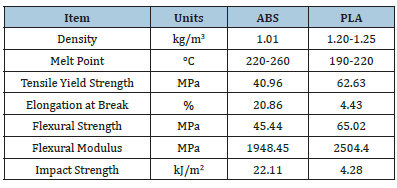
Experimental layout
Experimental studies were carried out on a CNC abrasive water jet processing machine. This machine is max. It can produce a pump pressure of 415MPa. Surface roughness values (Ra) were taken from four points in the middle of the workpiece and their averages were taken as basis. A new turning mechanism was developed by removing the negativities in the water jet turning mechanisms available in the literature. While existing turning arrangements are made open air, loud noise and water abrasive particles are scattered around. In this study, by means of submerged working, on the one hand, it was possible to prevent water splashing during contact with the workpiece, and on the other hand, it was possible to reduce the noise level during machining. The structure of the specially developed underwater turning experimental setup, in which the defects that occurred in the previous studies were eliminated (Figure 2). During the processing with submerged abrasive water jet, sound level measurement is observed (Figure 3).
Figure 2:Technical design and fabricated views of the newly designed AWJ system.

Figure 3:PLA and ABS cylindrical parts turning with submerged AWJ.
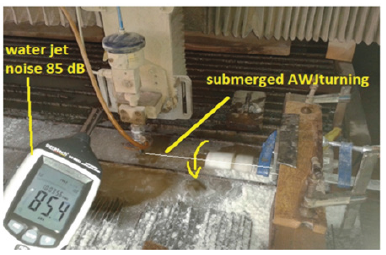
Test parameters and measurement
The parameters were determined based on the experiences obtained from the preliminary experiments and literature survey [14-18] (Table 2). Experiments were carried out at 350MPa pump pressure. Output parameters were measured with the Mitutoyo sj- 201 surface roughness measuring device in the same direction as the water jet.
Table 2:AWJ Processing levels and parameters.

Result and Discussion
Graphs and estimation equations were obtained by making nonlinear regression analysis on average surface roughness values obtained from the surfaces of processed plastic parts. The correlation between surface roughness and spindle speed in AWJ machining of ABS and PLA materials can be seen in Figure 4 and Figure 5. The average surface roughness value (5.80μm to 4.96μm to 17%) decreased as the lathe speed increased for PLA plastic material. High turnover speed has resulted in good macro surface quality. Similarly, for ABS material, when the rotation speed is increased from 85rpm to 235rpm, the average surface roughness value decreases from 5.80μm to 4.96μm and decreases by 14%.
Figure 4:The effect of turning rotation speed on the Ra when machining PLA material.
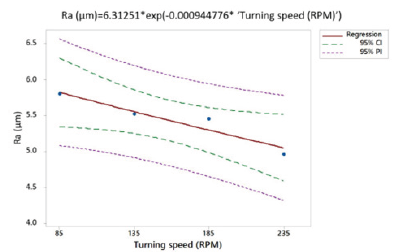
Figure 5:The effect of turning rotation speed on the Ra when machining ABS material.
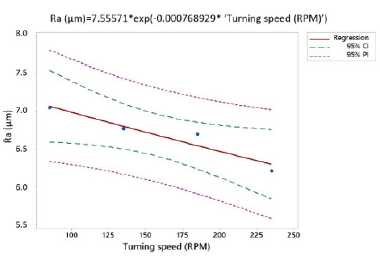
The Ra values obtained from experiments performed for ABS and PLA plastics using four different nozzle feed rates (Figure 6 and Figure 7). Ra increased by 26% (5.45μm to 7.37μm) when the nozzle feed rate for PLA was increased from 60mm/min to 210mm/ min. Ra increased 22% (6.70μm to 8.62μm) when the nozzle feed rate for ABS was increased from 60mm/min to 210mm/min. The increase in Ra values is due to the fact that the effect of abrasive water jet on the surface is not homogeneous and the processing time is shortened. The abrasive particles included in the water jet are not homogeneous in size. As the nozzle feed rate increases, the number of particles contacting the surface of the treated material will be reduced. For this reason, the particles which are not homogeneous and have less contact with the surface will not be able to provide a homogenous plastic deformation. This causes deterioration of surface quality, the findings present a good fit with the literature [19-21].
Figure 6:The effect of nozzle feed rate on the Ra when machining PLA material.

Figure 7:The effect of nozzle feed rate on the Ra when machining ABS material.
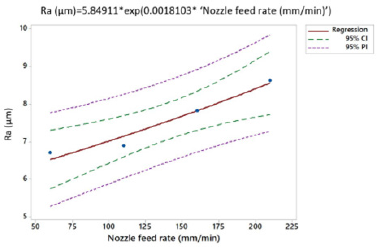
The variation of the abrasive flow rate in the AWJ turning method with the variation of the surface roughness values of PLA and ABS (Figure 8 and 9 Figure). Ra value for both PLA (6.58μm - 4.85μm) and ABS (7.82μm - 6.11μm) when the abrasive flow rate is increased from 160g/min to 235g/min. decreased by 35% for plastics. The higher abrasive flow rate improved the Ra values by providing a more stable cutting process. The increase in the abrasive flow rate will allow more abrasive particles to be contacted on the surface per unit time. The surface quality of the treated material has increased since this situation provides homogenization at the particle contacting surface. In addition, the increase in the amount of particles in the water jet provides the more rigid behavior of the jet. As the speed increases with increasing speed, more stable cutting will be expected.
Figure 8:The effect of abrasive flow rate on the Ra when machining PLA material.

Figure 9:The effect of abrasive flow rate on the Ra when machining ABS material.
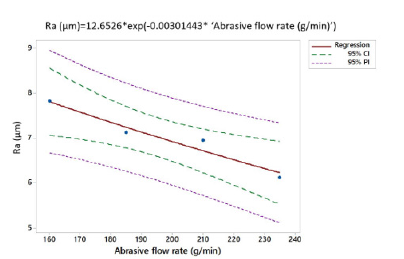
The Ra values obtained from experiments performed at four different nozzle distances (2, 4, 6 and 8mm) for PLA and ABS plastics (Figure 10 and Figure 11). It has been determined that increasing nozzle approach distance has a negative effect on average surface roughness. This can be explained by the nature of the jet produced by the nozzle. Degradation of the jet core results in the formation of rougher surfaces due to a larger and inhomogeneous impact. When the nozzle distance from PLA plastic material was increased from 3mm to 9mm, the average surface roughness values increased by 19% (5.07 3μm- 6.24μm). When the distance between the material and the nozzle was increased from 3mm to 9mm during machining, the average surface roughness value increased by 19% 5.07 3μm- 6.24μm for PLA material and 16% (6.17 3μm-7.35μm) for ABS material.
Figure 10:The effect of nozzle distance on the Ra when machining PLA material.
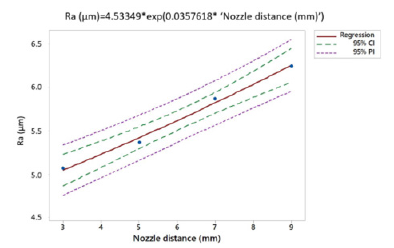
Figure 11:The effect of nozzle distance on the Ra when machining ABS material.
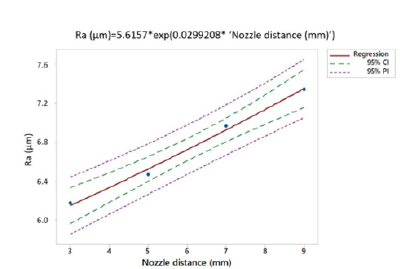
The surface roughness values were statistically significant. The variation of the input parameter and the variation of the surface roughness values and the estimation interval vary in the 95% confidence interval. Furthermore, the fact that the values change with the low differences along the linear axis in the center of the figure proves that the experimental results have a high regression coefficient (relation rate). It can be argued that the variation of the surface roughness values with the change of each parameter can be modeled as nonlinear regression (obtaining empirical equations) in the mathematical modeling stage. The macro surface view obtained at the nozzle feed rate 225mm/min (Figure 12.a). There are jet grooves and spiral cavities formed here. The cavities formed depending on the feed rate of the nozzle were obtained at 225mm/min. This value can be said to be high for the processing of plastic materials. The Scanning Electron Microscope (SEM) image of the machined ABS and PLA plastic material work piece, (Figure 12.b), because of the lower density of PLA material, it is more easily processed than ABS material and jet lines are not visible in the area processed behind the nozzle. One reason for this may be related to the density and mechanical properties of the material. PLA is more easily broken and hard surface. It is more likely to break when bent. The 3D models produced by PLA can be cut, grinded, painted and bonded with strong adhesives. 3D models manufactured with ABS are stronger and more impact resistant. Therefore, it is recommended to use in mechanical parts and against variable weather conditions. When plastic materials are tried to be processed with traditional methods, since heat is applied above the melting temperature (Tm) of plastics, it is not possible to process such materials because the material undergoes deformation. For this reason, plastic materials are produced by molding technique and used in industry with a limitation that does not allow processing. However, since the heat generated in the material during turning with water jet is transferred by means of water, high heat does not occur. Thus, it is possible to keep the plastic material below the glass transition temperature (Tg) value at which it will start to deform.
Figure 12:Machined ABS and PLA plastic parts. a. Macro images. b. SEM image.

Conclusion
The machinability of ABS and PLA materials was investigated by turning with abrasive water jet. The input parameters considered are nozzle distance, abrasive flow rate, nozzle feed rate and chuck rotation speed. The input parameters are determined as four levels and the surface roughness (output parameter - Ra) values are changed depending on the change of the levels. The following results were obtained from the studies carried out with the newly designed and developed experimental system.
The increase in flow rate (from 160g/min to 235g/min) and chuck speed (from 85rpm to 235rpm) resulted in a 35% and 26% decrease in the average surface roughness value, respectively. The increase in nozzle distance resulted in a 19% increase in the surface roughness value. Thus, it has been determined that the increase in flow rate and chuck speed improves the surface roughness, while the increase in nozzle distance worsens it. The most important problem in front of the processing of thermoplastics by removing sawdust is the melting and deformation of the part due to the high heat generated during processing. It can be said that an effective solution has been presented by overcoming this problem with the abrasive water jet turning method. It has been determined that this method, which eliminates all the costs such as tool supply, coating and renewing them as they wear, is a very economical method during the manufacturing process.
But the three major disadvantages of the process should not be ignored. The first is the difficulty of loom installation and sealing problems. The second element is that it is difficult to obtain adequate and desired surface quality. For this reason, roughing process is more effective in turning with abrasive water jet. The minimum surface roughness value obtained in the processing of ABS and PLA material is 4.86μm. This value is high even for roughing. For this reason, considering the industry expectations, the abrasive water jet turning method is difficult to use as final processing. The third factor is ergonomic factors. Due to the excessive noise of the water jet machine, operators need protective equipment. In this study, submerged turning operation was also carried out successful submerged, resulting in a lower noise level in the open atmosphere (85dB). In order to remove the mentioned disadvantages, further research is needed on the subject of abrasive water jet and submerged turning.
References
- Abeykoon C, Amphorn P, Fernando A (2020) Optimization of fused deposition modeling parameters for improved PLA and ABS 3D printed structures. International Journal of Lightweight Materials and Manufacture 3(3): 284-297.
- Kumar R, Singh R, Farina I (2018) On the 3D printing of recycled ABS, PLA and HIPS thermoplastics for structural applications. PSU Research Review.
- Camargo JC, Machado ÁR, Almeida EC, Silva EFMS (2019) mechanical properties of PLA-graphene filament for FDM 3D printing. The International Journal of Advanced Manufacturing Technology 103: 2423-2443.
- Dhinesh SK, Arun PS, Senthil KK, Megalingam A (2021) Study on flexural and tensile behavior of PLA, ABS and PLA-ABS materials. Materials Today: Proceedings 45: 1175-1180.
- Momber AW, Kovacevic R (2012) Principles of abrasive water jet machining. Springer Science & Business Media.
- Kim K, Kim J (2016) BN-MWCNT/PPS core-shell structured composite for high thermal conductivity with electrical insulating via particle coating. Int J Sci Technol Polymer 101: 168-175.
- Hofy M, Helmy MO, Palafox G, Kerrigan K, Scaife R, et al. (2018) Abrasive water jet machining of multidirectional CFRP laminates. Procedia Cirp 68: 535-540.
- Garikipati P, Balamurugan K (2021) Abrasive water jet machining studies on AlSi 7+ 63% SiC hybrid composite. In Advances in Industrial Automation and Smart Manufacturing , Springer, Singapore, pp. 743-751.
- Kumar KR, Sreebalaji VS, Pridhar T, (2018) Characterization and optimization of abrasive water jet machining parameters of aluminium/tungsten carbide composites. Measurement 117: 57-66.
- Pahuja R, Ramulu M, Hashish M (2019) Surface quality and kerf width prediction in abrasive water jet machining of metal-composite stacks. Composites Part B: Engineering 175: 107134.
- Nyaboro JN, Ahmed MA, Hofy H, Hofy M (2020) Fluid-structure interaction modeling of the abrasive waterjet drilling of carbon fiber reinforced polymers. Journal of Manufacturing Processes 58: 551-562.
- Tripathi DR, Vachhani KH, Bandhu D, Kumari S, Kumar VR, et al. (2021) Experimental investigation and optimization of abrasive waterjet machining parameters for GFRP composites using metaphor-less algorithms. Materials and Manufacturing Processes, 36(7): 803-813.
- Hocheng H (2011) Machining technology for composite materials: principles and practice. Hocheng H(Ed.), Elsevier, USA.
- Srivastava AK, Nag A, Dixit AR, Scucka J, Hloch S, et al. (2019) Hardness measurement of surfaces on hybrid metal matrix composite created by turning using an abrasive water jet and WED. IMEKO, Measurement 131: 628-639.
- Nag A, Ščučka J, Hlavacek P, Klichová D, Srivastava AK, et al. (2018) Hybrid aluminium matrix composite AWJ turning using olivine and Barton garnet. Int J Adv Manuf Technol 94(5-8): 2293-2300.
- Hutyrová Z, Ščučka J, Hloch S, Hlaváček P, Zeleňák M (2016) Turning of wood plastic composites by water jet and abrasive water jet. Int J Adv Manuf Technol 84(5-8): 1615-1623.
- Kartal F (2017) A review of the current state of abrasive water-jet turning machining method. Int J Adv Manuf Technol 88: 495-505.
- Hashish M (1984) A modeling study of metal cutting with abrasive waterjets. J Eng Mater Technol 106(1): 88-100.
- Hashish M (1987) Turning with abrasive-waterjets-a first investigation. J Eng Ind 109(4): 281-290.
- Hu D, Tang CL, Kang Y, Li X (2015) An investigation on cutting quality by adding polymer in abrasive water jet. Particulate Sci Technol 34(3): 352-358.
- Kartal F, Çetin MH, Gökkaya H, Yerlikaya Z (2014) Optimization of abrasive water jet turning parameters for machining of low density polyethylene material based on experimental design method. Int Polymer Processing 29(4): 535-544.
 a Creative Commons Attribution 4.0 International License. Based on a work at www.crimsonpublishers.com.
Best viewed in
a Creative Commons Attribution 4.0 International License. Based on a work at www.crimsonpublishers.com.
Best viewed in 







.jpg)






























 Editorial Board Registrations
Editorial Board Registrations Submit your Article
Submit your Article Refer a Friend
Refer a Friend Advertise With Us
Advertise With Us
.jpg)






.jpg)














.bmp)
.jpg)
.png)
.jpg)










.jpg)






.png)

.png)



.png)






